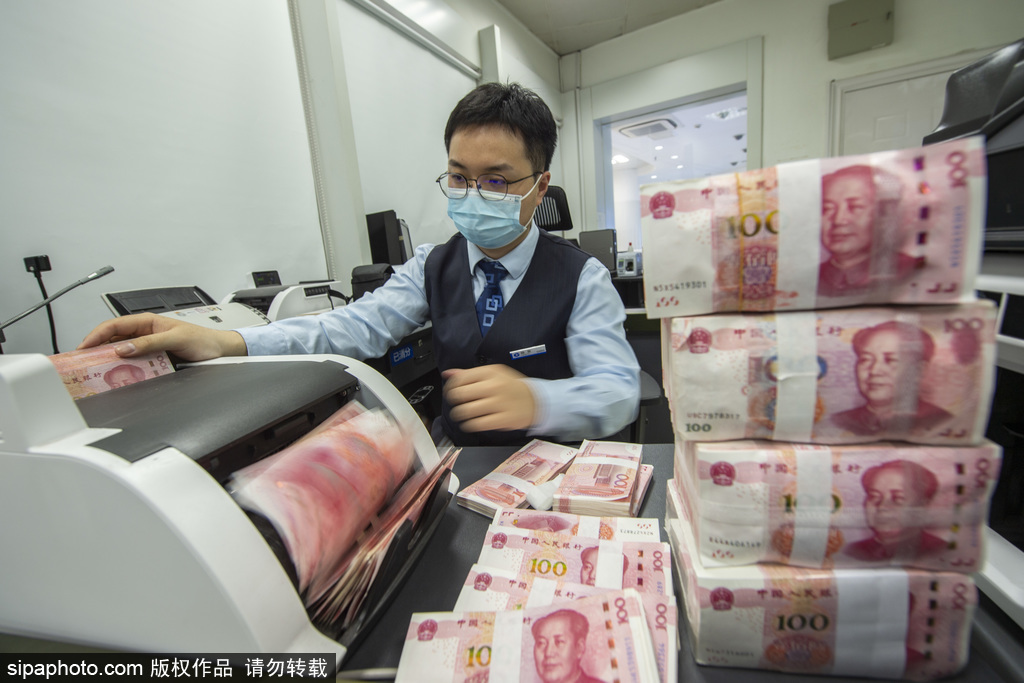
A teller counts renminbi banknotes at a bank in Nantong, Jiangsu province. [Photo/Sipa]
China has pursued high-quality development in all aspects to build a modern socialist country.
The rules and transparency of the RMB exchange rate formation mechanism have not only become an important guarantee for promoting high-quality development and high-level opening up, but also for China to promote the reform of the global governance system, It has become an important tool for maintaining the economy. Promote globalization and improve people’s welfare.
In promoting foreign exchange system reform, China has made significant progress, including supporting the improvement of the market-oriented mechanism of the renminbi exchange rate and further increasing the transparency of the process. The transition from a double-track system to a single rate system in 1994, and milestone events such as the 21 July Exchange Rate Reform in 2005 and the 11 August Exchange Rate Reform in 2015, all This is an important step in -led reform.
Moreover, dynamic policy adjustments and the fostering of market mechanisms have created a clear and transparent regulatory framework for the midpoint exchange rate of the renminbi against the US dollar.
Increasing the transparency of the RMB exchange rate will promote the coordinated development of both domestic and global factors and promote a high level of openness, which is mainly reflected in the following points:
Greater transparency in the RMB exchange rate has boosted confidence among market participants. When market participants have a clear understanding of the factors that influence exchange rates that cause exchange rate fluctuations, they are better able to assess risk and make informed investment and trading decisions.
For example, the flexibility of the renminbi’s exchange rate has provided market participants with flexibility in the face of significant challenges, such as trade tensions between China and the United States, the three-year-old coronavirus pandemic, and a turbulent international political and economic environment. adapts quickly to change. They can make timely adjustments to stabilize expectations, highlight the renminbi’s resilience in the face of shocks, and maintain fundamental stability.
Security and development priorities are balanced. A transparent exchange rate mechanism helps in early detection of potential financial risks. For micro-level participants such as businesses and investors, access to accurate and timely exchange rate information allows them to better assess exchange rate risks. This allows businesses to make informed decisions about cross-border transactions, investments, and risk mitigation. At the same time, it facilitates international trade and capital flows while reducing financial system vulnerabilities.
For macro-level stakeholders such as governments and central banks, transparent exchange rate mechanisms pave the way for more accurate assessment of the economic impact of exchange rate movements. This allows for the adjustment of monetary policy and macroeconomic measures, which helps maintain economic stability and sustainable development.
A more transparent Renminbi exchange rate will support China’s cooperation and engagement with other countries and international organizations, and further promote financial openness and the internationalization of the Renminbi. For example, against the backdrop of a flawed international monetary system based on the US dollar and continued efforts to reshape the international financial landscape, increased transparency in the renminbi exchange rate could increase China’s involvement in global governance reform. There is.
Transparency in the renminbi’s exchange rate will also enhance China’s international reputation and help counter a series of baseless claims from the West.
The transparency and clarity of the RMB exchange rate has helped promote China’s high-quality development and high-level opening up. Through sustained and deepening reform, China’s foreign exchange market mechanism has been significantly improved. However, some international organizations continue to turn a blind eye to the achievements of China’s foreign exchange system reform and market-driven development, and at times downplay the transparency of the renminbi exchange rate.
China’s foreign exchange market has undergone gradual reform, and supply and demand factors are increasingly influencing exchange rate determination, and the fluctuation of the RMB exchange rate is mainly due to market fluctuations rather than government manipulation. It is formed by mechanics.
Because China holds large foreign exchange reserves, the People’s Bank of China (the country’s central bank) is able to maintain a stable exchange rate for the renminbi. This has made market investors more confident in the stability of the Chinese currency.
The exchange rate of the Renminbi is also affected by the global economic environment, such as international trade trends and interest rate differentials. Therefore, the fluctuation of the RMB exchange rate is mainly caused by market demand and supply, and the so-called “manipulation” by the Chinese government is a baseless accusation.
The RMB exchange rate serves as an important link connecting domestic and foreign organizations across the economic and financial sectors, making the foreign exchange market a key area for achieving a high level of openness. In recent years, the People’s Bank of China has strengthened its international communication efforts and disseminated information on China’s foreign exchange market reforms and achievements.
These efforts have deepened global understanding of RMB exchange rate transparency, highlighted China’s commitment to reforming foreign exchange market rules and regulations, and promoted a high level of openness. These efforts have dispelled misconceptions about China’s exchange rate policy.
Moreover, through enhanced cooperation with other countries and regions, the Chinese central bank has contributed to promoting reforms and promoting improvements in the international monetary system.
The People’s Bank of China is also strengthening cooperation with other countries, international organizations, and market regulators in the foreign exchange market. This collaborative approach will foster information sharing and jointly promote greater transparency and stability in global foreign exchange markets.
The author is vice president of the Central University of Finance and Economics.
The views do not necessarily represent those of China Daily.

